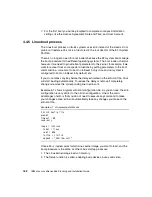
Chapter 4. Installation
151
4.4 Installing Linux
The goal of the project to port the Linux kernel to the Itanium platform was to
have a single optimized port of the Linux kernel for every Itanium-based machine.
The kernel has been available at
http://www.kernel.org
since early 2000.
The development model used to create this new porting of the kernel was the
same as used for other Linux development work: Open source developers
working together around the world on a cooperative effort to make it available
before any other operating system and even before the official release of the
processor itself. This is one of the key points of Linux’ success, and also of this
Itanium 2 port of the kernel.
This effort was also possible thanks to many companies and institutions that
contributed on this development effort, such as Intel, IBM, HP, Caldera (now SCO
Group), the European Organization for Nuclear Research (CERN), Red Hat,
SGI, SUSE LINUX, Turbolinux, and VA Linux Systems (now VA Software).
Each company distributed the work among their developers to achieve the best
results. The main tasks were:
Port the kernel itself
Initial port of GNU Compiler Collection (GCC) to IA-64 architecture
Port of GAS, emacs, ld, GNUPro toolkit
Port of performance, measurement, and analysis tools
Intel provided the IA-32 and IA-64 platform specifications and the EFI, and
helped on the Apache port. The rest of the work was distributed among the
companies involved, and also by private individuals around the world.
Linux for IA-64 provides a pure 64-bit kernel but maintains compatibility at the
API level with Linux for x86 wherever this is possible. The error messages, the
system signal, and the ioctl codes will remain as compatible as possible between
the two platforms. Also in this version, as started in the Linux kernel from Version
2.1.126 onwards, developers tried to minimize changes to make the code as
platform-independent as possible, while optimizing the platform-specific features
to improve performance on Itanium processors.
The IA-64 Linux kernel follows the standards defined by Intel and other
companies. These include:
EFI (Extensible Firmware Interface); see:
http://developer.intel.com/technology/efi/
DIG64 (Developers Interface Guide for 64-bit Intel Architecture Servers); see:
http://www.dig64.org
Summary of Contents for 88553RX
Page 2: ......
Page 214: ...200 IBM Eserver xSeries 455 Planning and Installation Guide Figure 5 14 Connect to the x455...
Page 228: ...214 IBM Eserver xSeries 455 Planning and Installation Guide...
Page 229: ...IBM Eserver xSeries 455 Planning and Installation Guide...
Page 230: ......
Page 231: ......
















































